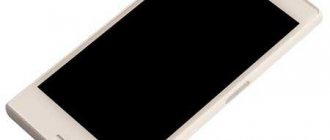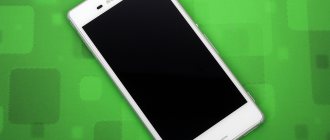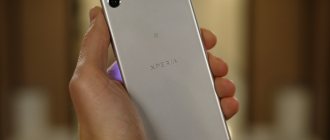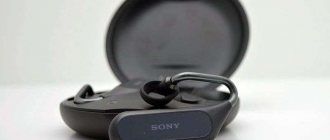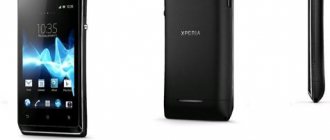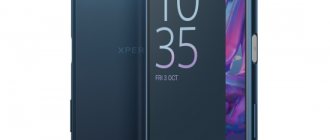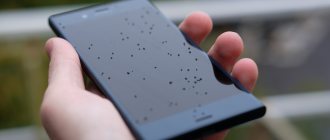Specifications
| Colors | Black, purple, gray, white |
| Display | 6.5 inches, 1644 × 3840 pixels, OLED |
| CPU | Seven-nanometer Snapdragon 855 (1 × 2.84 GHz Kryo 485 + 3 × 2.42 GHz Kryo 485 + 4 × 1.78 GHz Kryo 485) |
| GPU | Adreno 640 |
| RAM | 6 GB |
| Built-in memory | 64/128 GB + microSD support up to 512 GB |
| Cameras | Rear - 12 MP (main) + 12 MP (telephoto) + 12 MP (ultra-wide-angle). Front - 8 MP |
| SIM card | Two slots for nanoSIM (one hybrid with microSD) |
| Wireless interfaces | Wi‑Fi 802.11 a/b/g/n/ac, Bluetooth 5.0 with aptX, GPS, NFC |
| Connectors | USB Type-C |
| Unlock | By fingerprint, PIN code |
| operating system | Android 9.0 |
| Battery | 3,330 mAh, fast charging supported (18 W, USB Power Delivery 2.0) |
| Dimensions | 167 × 72 × 8.2 mm |
| Weight | 178 g |
⇡#Technical characteristics
| Sony Xperia 1 | Huawei P30 Pro | Samsung Galaxy S10+ | Apple iPhone Xs Max | OnePlus 7 Pro | |
| Display | 6.5 inches, OLED, 3840 × 1644 pixels (21:9), 643 ppi, capacitive multi-touch | 6.47 inches, OLED, 2340 × 1080 pixels (19.5:9), 398 ppi, capacitive multi-touch | 6.4 inches, Super AMOLED, 1440 × 3040 (19:9), 522 ppi, capacitive multi-touch | 6.5 inches, Super AMOLED, 2688 × 1242 (19.5:9), 458 ppi, capacitive multi-touch, TrueTone technology | 6.67 inches, AMOLED, 3120 × 1440 pixels (19.5:9), 516 ppi, capacitive multi-touch |
| Protective glass | Corning Gorilla Glass 6 | No information | Corning Gorilla Glass 6 | No information | Corning Gorilla Glass 5 |
| CPU | Qualcomm Snapdragon 855: eight cores (1 × Kryo 485 Gold, 2.84 GHz + 3 × Kryo 485 Gold, 2.42 GHz + 4 × Kryo 485 Silver, 1.8 GHz) | HiSilicon Kirin 980: eight cores (2 × ARM Cortex A76, 2.6 GHz frequency + 2 × ARM Cortex A76, 1.92 GHz frequency + 4 × ARM Cortex A55, 1.8 GHz frequency); HiAI architecture | Samsung Exynos 9820 Octa: eight cores (2 × Mongoose M4, 2.73 GHz + 2 × Cortex-A75, 2.31 GHz + 4 × Cortex-A55, 1.95 GHz) | Apple A12 Bionic: six cores (2 × Vortex + 4 × Tempest) | Qualcomm Snapdragon 855: eight cores (1 × Kryo 485 Gold, 2.84 GHz + 3 × Kryo 485 Gold, 2.42 GHz + 4 × Kryo 485 Silver, 1.8 GHz |
| Graphics controller | Adreno 640 | ARM Mali-G76 MP10, 720 MHz | ARM Mali-G76 MP12 | Apple GPU (4 cores) | Adreno 640 |
| RAM | 6 GB | 8 GB | 8/12 GB | 4 GB | 6/8/12 GB |
| Flash memory | 64/128 GB | 128/256/512 GB | 128/512/1024 GB | 64/256/512 GB | 128/256 GB |
| Memory card support | Yes (microSD up to 512 GB) | Yes (Huawei nanoSD only) | Yes (microSD up to 1 TB) | No | No |
| Connectors | USB Type-C | USB Type-C | USB Type-C, 3.5 mm mini-jack | Lightning | USB Type-C |
| SIM cards | Two nano-SIMs | Two nano-SIMs | Two nano-SIMs | One nano-SIM and one eSIM | Two nano-SIMs |
| Cellular connection 2G | GSM 850 / 900 / 1800 / 1900 MHz | GSM 850 / 900 / 1800 / 1900 MHz | GSM 850 / 900 / 1800 / 1900 MHz CDMA 800 | GSM 850 / 900 /1800 / 1900 MHz CDMA 800 / 1900 | GSM 850 / 900 / 1800 / 1900 MHz |
| Cellular 3G | HSDPA 800 / 850 / 900 / 1700 / 1900 / 2100 MHz | HSDPA 800 / 850 / 900 / 1700 / 1900 / 2100 MHz | HSDPA 850 / 900 / 1700 / 1900 / 2100 MHz | HSDPA 800 / 850 / 900 / 1700 / 1800 / 1900 / 2100 MHz | HSDPA 800 / 850 / 900 / 1700 / 1900 / 2100 MHz |
| Cellular 4G | LTE Cat. 19 (up to 1600/150 Mbit/s), bands 1, 2, 3, 4, 5, 7, 8, 12, 13, 17, 19, 20, 26, 28, 29, 32, 38, 39, 40, 41, 46, 66 | LTE Cat. 21 (up to 1400/150 Mbit/s), bands 1, 2, 3, 4, 5, 6, 7, 8, 9, 12, 17, 18, 19, 20, 26, 28, 34, 38, 39, 40 | LTE Cat. 20 (up to 2000/150 Mbit/s), bands 1, 2, 3, 4, 5, 7, 8, 12, 13, 17, 18, 19, 20, 25, 26, 28, 32, 38, 39, 40, 41, 66 | LTE Cat. 16 (1024/50 Mbps): bands 1, 2, 3, 4, 5, 7, 8, 12, 13, 14, 17, 18, 19, 20, 25, 26, 29, 30, 32, 34 , 38, 39, 40, 41, 66, 71 | LTE Cat. 19 (up to 1600/150 Mbit/s), bands 1, 2, 3, 4, 5, 7, 8, 12, 13, 17, 18, 19, 20, 26, 28, 29, 32, 38, 39, 40, 41, 66 |
| WiFi | 802.11a/b/g/n/ac | 802.11a/b/g/n/ac | 802.11a/b/g/n/ac | 802.11a/b/g/n/ac | 802.11a/b/g/n/ac |
| Bluetooth | 5.0 | 5.0 | 5.0 | 5.0 | 5.0 |
| NFC | Eat | Eat | Eat | Yes (Apple Pay) | Eat |
| Navigation | GPS (dual band), A-GPS, GLONASS, BeiDou, Galileo | GPS (dual band), A-GPS, GLONASS, BeiDou, Galileo, QZSS | GPS (dual band), A-GPS, GLONASS, BeiDou, Galileo | GPS, A-GPS, GLONASS, Galileo, QZSS | GPS, A-GPS, GLONASS, Galileo, BeiDou, SBAS |
| Sensors | Light, proximity, accelerometer/gyroscope, barometer, magnetometer (digital compass), color spectrum sensor | Light, proximity, accelerometer/gyroscope, magnetometer (digital compass), IR sensor | Light, proximity, accelerometer/gyroscope, barometer, magnetometer (digital compass), heart rate sensor | Illumination, proximity, accelerometer/gyroscope, magnetometer (digital compass), barometer | Illumination, proximity, accelerometer/gyroscope, magnetometer (digital compass), barometer |
| Fingerprint's scanner | Yes, on the right side | Yes, on the screen | Yes, on the screen | No | Yes, on the screen |
| Main camera | Triple module, 12 + 12 + 12 MP, ƒ/1.6 + ƒ/2.4 + ƒ/2.4, phase detection autofocus, LED flash, five-axis optical stabilization in the main and TV modules | Quadruple module, 40 + 20 + 8 MP (periscope) + TOF, ƒ/1.6 + ƒ/2.2 + ƒ/3.4, phase detection autofocus, optical stabilization, dual LED flash | Triple module: 12 MP with variable aperture ƒ/1.5/2.4 + 12 MP, ƒ/2.4 + 16 MP, ƒ/2.2, phase detection autofocus, optical stabilization in the main and TV modules, LED flash | Dual module: 12 MP, ƒ/1.8 + 12 MP, ƒ/2.4, autofocus, quad-LED flash, optical stabilizer in both cameras | Triple module, 48 + 8 + 16 MP, ƒ/1.6 + ƒ/2.4 + ƒ/2.2, phase detection autofocus, dual LED flash |
| Front-camera | 8 MP, ƒ/2.0, fixed focus, no flash | 32 MP, ƒ/2.0, fixed focus, no flash | Dual module: 10 + 8 MP, ƒ/1.9 + ƒ/2.2, autofocus with main camera | 7 MP, ƒ/2.2, no autofocus, no flash | 16 MP, ƒ/2.0, fixed focus, retractable design |
| Nutrition | Non-removable battery: 12.65 Wh (3330 mAh, 3.8 V) | Non-removable battery: 15.96 Wh (4200 mAh, 3.8 V) | Non-removable battery: 15.58 Wh (4100 mAh, 3.8 V) | Non-removable battery: 12.06 Wh (3174 mAh, 3.8 V) | Non-removable battery: 15.2 Wh (4000 mAh, 3.8 V) |
| Size | 167 × 72 × 8.2 mm | 158 × 73.4 × 8.4 mm | 157.6 × 74.1 × 7.8 mm | 157.5 × 77.4 × 7.7 mm | 162.6 × 75.9 × 8.8 mm |
| Weight | 178 grams | 192 grams | 175 grams | 208 grams | 206 grams |
| Housing protection | IP65/IP68 | IP68 | IP68 | IP68 | No data |
| operating system | Android 9.0 Pie | Android 9.0 Pie, EMUI shell | Android 9.0 Pie, own shell | iOS 12 | Android 9.0 Pie, OxygenOS 9.5.8 |
| Current price | 79,990 rubles | 69,990 rubles for the version with 256 GB of memory | 76,990 rubles for the 8/128 GB version, 124,990 rubles for the 12/1024 GB version | From 70,000 rubles for the 64 GB version to 104,000 rubles for the 512 GB version | from 55,600 rubles for the 8/256 GB version to 64,000 rubles for the 12/256 GB version |
Appearance and ergonomics
Sony Xperia 1 is sold in four colors: black, purple, gray and white. We received a gray smartphone. The color is dull and discreet, not silver or metallic.
The back panel is glass, the frames are metal. In terms of tactile sensations, the smartphone is excellent: moderately weighty, it is pleasant to hold in your hand.
The first thing that immediately catches your eye is its elongated shape. It looks great, but as long as a TV remote control, the smartphone does not fit comfortably in every pocket.
The next feature is the right side filled with different things. From top to bottom there are: a paired volume key, a fingerprint sensor, power and camera buttons. The left side of the smartphone is empty. At the bottom there is a speaker hole and a USB Type-C input.
At the top is a slot for nanoSIM. Removable without a paperclip.
The declared protection class is IP65/68. This means that you can take your smartphone out in the rain and spill water on it.
Sony shows character again: Xperia 1 is not similar to other models on the market, nor to the company's previous devices. And this is the smartphone that you can quickly examine and say: “Sony made it exactly.” Design trends from the outside don’t seem to get here: the company comes up with devices itself, and does it right. It seems that cutouts in the screen and vertical modules in the corner of the rear panel simply would not suit them.
Screen
The display is contrasty, detailed and perfectly calibrated. In some scenarios it lacks brightness, but this is not critical.
The Xperia 1 has frames, and they suit it well. Sony has shown that you can make a stylish smartphone without filling the entire front panel with a screen.
The company made serious bets on technical characteristics. This is not only 4K resolution and HDR, but also less clear specifications: 10-bit color depth, support for image remastering technology, wide color space ITU-R BT.2020 and DCI-P3 with D65 illuminator. All this sounds great, but does not in any way affect the experience of using a smartphone. The screen here is perceived as a flagship one, but it is not clear how to use its technical bells and whistles and whether it is necessary. Perhaps this will be useful for mobile photographers and videographers (we will touch on the features of video shooting later).
With screen proportions of 21:9 it is convenient to watch suitable content, but there is one caveat. Almost all content on the Internet is inappropriate. Most videos will appear either without a bottom or top, or with empty margins on the sides. But this is where the split-screen feature can really come in handy. Its fans note that it is convenient to use even messenger with a keyboard.
Camera
Three lenses are responsible for shooting: the main lens, the ultra-wide-angle lens and the telephoto lens. The latter only works in good light - in the dark the main camera with a crop is turned on. The ultra-wide-angle lens here has a pronounced fisheye effect, which is noticeable when shooting close up. Here are the photos that are taken in the sun: first there is a frame taken with an ultra-wide-angle lens, then with the main camera, then with a telephoto lens.
The photographs have a characteristic sharpness. There is an opinion that this is due to the RAW noise reduction technology introduced into the Xperia 1 from Sony Alpha cameras.
And this is how the Xperia 1 camera shoots at night. In automatic mode, sometimes there is not enough light, but you can resort to manual mode and, for example, increase the shutter speed. Maximum - 30 seconds.
Sony has focused on fast and correct autofocus when shooting people; it occurs based on the eyes. And the attitude towards this update is approximately the same as towards the technical bells and whistles of the screen: great, but it doesn’t particularly affect the impressions or the work with the smartphone.
The camera can also automatically detect shooting scenarios and adjust the exposure to suit them. A portrait mode with bokeh is available.
The front camera takes good pictures during the day. At night it is noticeably worse.
The camera button highlighted on the right edge comes in handy. It's conveniently located and you'll actually use it.
Sony paid special attention to video shooting. The Xperia 1 has a pre-installed application called Cinema Pro, which emulates the work of a professional cinema camera. You can shoot in 4K or 2K with stabilization. Here you can also adjust the frame rate and select a camera profile.
I tried to shoot a video on the Sony CineAlta Venice full-frame movie camera emulator. ISO, shutter speed and white balance were manually set. Some shots were manual focus, and different lenses were also used.
This is the result. The video, of course, is meaningless, but the picture is nice.
I really enjoyed filming videos with manual settings and watching them. You might not be making movies with the Xperia 1 and Cinema Pro, but you'll definitely want to give it a try.
⇡#Cameras
Let's be happy for Sony - common sense has finally triumphed. The Xperia 1 has a triple main camera module, but this is not the main thing. The main thing is that the company has abandoned the previous high-resolution sensors (19, 21 and 23 megapixels) and opted for 12 megapixel BSI-CMOS sensors in all three cameras. However, the optics are different.
The main camera has a lens with an equivalent focal length of 26 mm and an aperture of ƒ/1.6. It has optical stabilization and phase detection autofocus with Dual Pixel technology. The telephoto lens has twice the focal length (52 mm equivalent, ƒ/2.4), which gives us a 2x optical zoom. There is also optical stabilization here - I would say that its presence is much more important here, and PDAF autofocus. The third lens is an ultra-wide-angle (16 mm, ƒ/2.4), and it no longer has automatic focusing or stabilization. It should be noted that at this focal length the depth of field is so great that autofocus is not needed, except perhaps for shooting very close objects. But let's be lenient, because what Sony has implemented in the Xperia 1 is already a huge improvement over what came before.
The shooting interface is simple and minimalistic, making it easy to work with. Switching between cameras occurs sequentially. By default, the main camera with a 26 mm lens is always activated, the first press on the dedicated button activates double zoom, that is, switches to the telephoto lens, and the second press turns on the ultra-wide-angle camera, with a one and a half to two second delay. What this is connected with is difficult to say. I hope this is a small software glitch that will be fixed in the next firmware update.
Gallery of pictures
View all images (26)The quality of shooting by Sony standards is simply incredible: detail does not suffer, color reproduction is good, high sharpness is as natural as possible (instead of using the Sharpen filter) - in general, all this is absolutely amazing, as you can see for yourself in the examples above. There is a good portrait mode that copes not only with a living person, but also, for example, with a monument.
| Examples of shooting on Xperia 1 in portrait mode | ||
It’s a pity that there is no separate night shooting mode in the Xperia 1. The smartphone perfectly recognizes scenes and displays the name in the lower left corner of the screen, but this does not affect the quality of shooting in the dark. Sony still lags behind Google, Samsung and Huawei. However, I would refrain from drawing conclusions for now: let's just wait for all the flagships of this year - the new iPhone, the new Pixel - and arrange a big comparison test.
The front camera is familiar from other Sony smartphones - it is an 8-megapixel sensor and a lens with a focal length of 24 mm equivalent, ƒ/2.4. There is no autofocus, there is no separate flash - it is quite successfully replaced by the display, which has long been a standard feature at the behest of Apple. I would characterize the quality of shooting self-portraits as average - nothing outstanding. The most important thing (for me personally, at least) is the ability to completely disable intrusive beauty and present faces in their original form, with all skin imperfections and natural age-related changes.
| Examples of shooting with the front camera of Xperia 1 | ||
Video recording is possible in 2160p resolution at 30 frames per second. There is no 4K recording at 60 frames per second on the Xperia 1, although the Snapdragon 855 supports it perfectly. 60 fps can only be obtained by switching the resolution to Full HD; slow motion shooting at a frequency of 960 frames per second is also possible in it.
Example of shooting on Sony Xperia 1 in 4K 30p
An example of shooting on an Apple iPhone Xs Max in 4K 60p
And, with all the technological advantages (good bitrate, stabilization that works at maximum resolution), it is clear that the Sony Xperia 1 still does not reach the iPhone Xs Max in video quality. Notice how the frame jerks as it moves.
A separate item on the program at the Sony Xperia 1 presentation was the Cinema Pro application, developed in collaboration with the CineAlta division (most high-budget films are shot on their cameras). This application allows you to shoot video with manual settings and overlay color profiles typical of CineAlta cinema cameras. At first glance, the idea is good, but the application interface can hardly be called thoughtful. Yes, it looks professional, but it's much less convenient to use than a standard shooting application.
Yes, here we have more manual settings, right down to ISO setting, shutter speed selection and even manual focusing. But let's be honest: manually focusing on a smartphone when shooting handheld video is an extremely dubious pleasure. And automatic focusing in the Cinema Pro application only works in the center of the frame and does not allow the use of tracking mode with keeping focus on a person’s eyes. In general, the presence of this application does not interfere with life at all, but it seems to me that for serious shooting (even if not cinema, but at least a travel blog or something similar), a standard application, and at the same time an external stabilizer like DJI Osmo, is much better suited Mobile or Zhiyun Smooth 4.
Software
The smartphone runs Android 9.0 with a small number of add-ons from Sony. The classic arrangement of icons and the recommendations panel from Google on the left screen have been preserved.
Also, by swiping from above, the quick access panel is called up. The other panel, with applications, opens with a gesture that we already tried to master when testing previous Sony models. To activate the panel, you need to lightly click on the side edges twice. It's not always successful on the first try.
From Sony, the smartphone received a small set of pre-installed services and a game mode that optimizes the system for maximum performance or autonomy when loading heavy applications. Sony's not very convenient gestures when taking selfies (reaction to a smile or palm movements) are also supported. An unobvious discovery was continuous typing, enabled by default.
This is a completely convenient and understandable system with several bells and whistles, which, even if not useful, at least do not interfere. However, during testing, the smartphone began to crash: the camera application froze when trying to take a photo. Reboot helped. Perhaps such bugs will be fixed with new firmware.
Results
Sony Xperia 1 can be criticized for many things, for example, for the sharpness of frames, strange software features, an awkward position in your pocket, and a still defective fingerprint sensor. And also for the price: Sony firmly believes in its brainchild, selling it for 79,990 rubles. In other stores, a smartphone can be found for about 60 thousand.
Trying to outperform its competitors in terms of performance, the company is clearly choosing the wrong thing to compete in. What does it matter if the screen supports DCI-P3 technology with D65 illumination if almost no one understands what it means? Such nuances are not visible from afar - it’s hard to say that the display here is better than that of the flagships of Samsung, Apple or Xiaomi.
Sony Xperia 1 is a smartphone with its own character and is not for everybody. It looks and works differently than others, and there is no one to compare it to. A gadget can give you a new experience: in my case, it was, for example, the experience of shooting video in Cinema Pro. However, the verdict remains in force: for now, Sony’s destiny is cameras and game consoles. They are clearly better for the company than smartphones.
Buy
The author expresses gratitude to Sony for providing the device for testing.
Sony Xperia 1
Sony is trying to stand out in the mobile market, and it does this in several ways. Firstly, all fans of the brand could not help but notice that Sony was demonstrating its flagships at the MWC exhibitions at the end of February. Secondly, the new Sony Xperia 1 received an atypical name if you compare the smartphone with its predecessors in the series. And thirdly, we can still see the design characteristic of Xperia, which does not evoke any associations with the painful Apple products. But let’s look at all the interesting features of the new product.
Design and positioning
As practice has shown, changes always attract the attention of the audience, no matter for the worse or for the better. In the case of Sony Xperia 1 there are several of them:
- There are no longer letter indices in the name, only a number, it seems that the company decided to do it like in Nokia;
- The key feature of the model was the new ratio – 21:9;
- Accordingly, the device received a non-standard 6.5” diagonal and a resolution of 3840 by 1644 pixels;
- In general, the design turned out to be canonical, without eyebrows, holes and other attributes that are questionable for conservative users.
It’s hard to say how much more popular this aspect ratio will be than the usual 16:9 when watching wide-screen films, but it certainly won’t hurt in games, because it’s no secret that the joystick takes up more than 20 percent of the free space. Also, an elongated screen will be more convenient in dual-window mode.
Options
By the way, about games: the smartphone will be equipped with the current processor from Qualcomm, Snapdragon 855 series. This is a new chipset made using the 7nm process technology, which is also used in the Chinese version of the Samsung Galaxy S10. The battery in the Samsung competitor is also comparable, if you do not take into account the difference of tens of hours. But Sony didn’t bother chasing RAM; the device has 6GB, which should be enough for most tasks. But with the cameras, everything is as it should be: there are three of them, including a lens and a wide-angle, there is optical stabilization and f/1.6 in the main module. Needless to say, the Sony Xperia 1 can shoot video in the same ratio, in 4K with HDR.
Bottom line
The new solution is thinner than its predecessors and weighs less. The finger scanner for unlocking has again been returned to the end on the right, and due to patent disputes it is not combined with the power button. It is impossible to say whether the emphasis on 21:9 and the absence of a 3.5 mm jack will be justified, but the company’s designers are still following their course, and it is this feature that attracts fans of the brand.


